On December 22, 1917, Mother Cabrini died. Today in celebrating this important anniversary, we want to make a tour among the most important relics of our Saint.
But first, let us begin by discovering what lies behind the term “relic” from an historical point of view.
When the memory of a saint is meant to be honored, the relics are preserved. The veneration of relics is a very ancient practice belonging to the Church. Although we know of some preserved and known in the secular world, these mostly belong to the sphere of martyrs for the faith. Even today, during the consecration rite of a new church, some relics are placed beneath the altar as an expression of communion with the “Body and Blood of the King of Martyrs.” What creates communion is indeed the offering of one’s life, following the example of Christ. In history then, relics have become gifts of immense value, not only religious but also diplomatic and political, which are sent as a sign of communion. While the Church in the East has been in favor of the fragmentation of bodies from the very beginning, the Catholic Church has held different positions; only today has it returned to its own original position. In its recent instruction, Relics in the Church: authenticity and preservation (2017), it recommends that, on the occasion of a beatification or canonization, only “small parts or fragments, already separated from the body,” should be taken from the tomb. Dismemberment of a body to make “distinguished relics” may only be permitted in exceptional cases by the Congregation for the Causes of Saints. The Directory on Popular Piety and Liturgy (2002) issued under John Paul II clarifies that relics are not only the bodies of the saints – or parts of them – but also objects such as furnishings, vestments, and manuscripts, and objects that have been placed in contact with their bodies or their tombs, such as oils, linen cloths (brandea), and even with venerated images.
*1 For this in-depth study, our source was Credere magazine
• First-class relics consist of the mortal remains or what remains of them.
• The second class denotes clothing and devotional objects used by the saint while alive.
• The third class, on the other hand, refers to the brandea, which are pieces of cloth placed in contact with the first- or second-class relics. *1
As for Mother Cabrini’s first-class relics, they are found mainly in Italy and in the United States.
We start with Northern Italy, in Codogno where the heart of the Saint is preserved in the Mother Cabrini Spirituality Center, specifically in the Tabor Church.
We started from this relic because Codogno, where the heart is kept, was the place that saw the birth and foundation of the Institute of the Missionaries of the Sacred Heart of Jesus. This year in particular, our Institute is celebrating the 80th anniversary of the arrival of this relic in Codogno.

It was December 17, 1942 when the precious relic of Mother Cabrini’s heart arrived in Codogno. The “Violets of Mother Cabrini,” an historic quarterly magazine of the Missionaries of the Sacred Heart of Jesus, records this event as follows: “The precious relic of the Heart of the Blessed Cabrini was carried in procession to Codogno by H. E. Msgr. Calchi Novati, Bishop of Lodi, amidst the exultation of the population. Military and civil authorities, soldiers in the ranks and masses of cheering and praying faithful flocked to pay homage to the Blessed. Those who remembered the Blessed One could not hold back their tears at seeing her triumph, and invoked her, the helpful and auspicious one, in that solemn hour. It seemed as if the Extraordinary Woman were really returning. The little Sister who from Codogno had launched into a missionary activity destined to expand across the whole world.”
In Codogno, there also another relic of Mother Cabrini which is held in the Parish of St. Blaise and the Blessed Immaculate Virgin, the radius.
We move nearby to Sant’Angelo Lodigiano, Mother Cabrini’s birthplace, where two of her relics are kept.
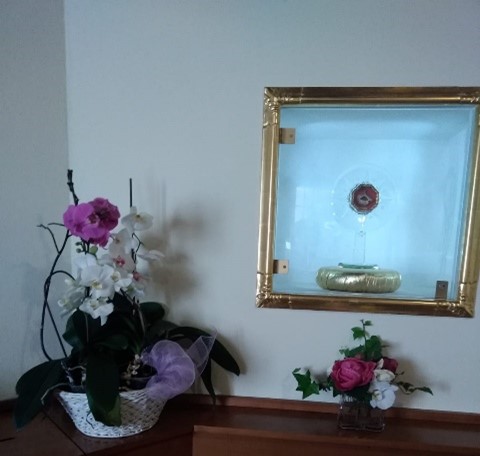
The first one in the Birthplace Museum, is a cervical vertebra. In the museum next to two other rooms is a small chapel with a picture of the Sacred Heart and the Saint’s relic in a reliquary: it is a small place for prayer and meditation, facing directly onto St. Cabrini Street, offering the pilgrim a place for a brief pause in silence.
(http://www.santacabrinicasanatale.com/)
The second relic is kept in the Basilica of Saints Anthony Abbot and Frances Cabrini, in the Saint Frances Cabrini Chapel. Here the canvas depicting the young Mother Cabrini seemingly freed from all earthly ties, hovering in the air against a background of sea and sky, dominates the central part, the work of the famous painter, Galizzi; the other two paintings by the painter Cesare Secchi depict assistance to immigrants and educational work among the youth. The marble altar is surmounted by the precious reliquary containing the saint’s ulna bone.
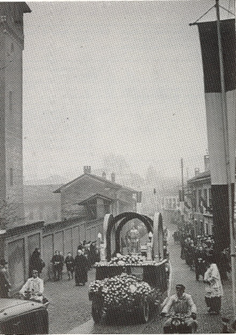
But how did this relic arrive in Sant’Angelo Lodigiano?
Here is the story:
On November 20, 1938, seven days after the solemn Beatification in St. Peter’s, the precious relic of Mother Cabrini was brought to Sant’Angelo. The ulna of the Saint’s right arm is enclosed in an artistic little temple of gilded bronze with a base and small column of fine marble, the work of goldsmith, Riccardo Politi of Milano. The procession composed of about one hundred and twenty cars, departed Lodi Cathedral with Bishop Monsignor Calchi Novati, religious and political authorities, teachers and the people. The chariot, surmounted by four arches, adorned with white carnations, roses and lights, passed between two groups of the people, arousing emotion and enthusiasm. All along the route, at S. Fereolo, at Muzza, at Pieve Fissiraga, everywhere, the road was adorned with triumphal arches, bells rang and people awaited with flags. These moments will never be forgotten. Pictured: the passing of the procession with Mother Cabrini’s relic on Cesare Battisti Street, on the right is a glimpse of Father Nicola De Martino.
(Source: Local history sheet)
Also in Sant’Angelo Lodigiano, kept in the Little Chapel of the Missionary Sisters of the Sacred Heart of Jesus, we find a small piece of Mother Cabrini’s heart.
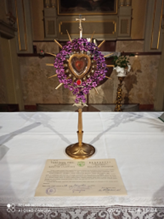
From here we move to Rome where Mother Cabrini’s skull is kept in the Church of the Redeemer on Via Sicilia.
Here, too, it is symbolic that the head is in Rome, the nerve center of the Papal State, but it is also the church desired and built by Mother Cabrini herself. The church was, in fact, founded by St. Cabrini in July 1900, in a building that was part of Villa Ludovisi which, after Mother Cabrini’s Canonization, was dedicated to her: this distinguished relic of the Saint is preserved in addition to the painting of the “Mother of Immigrants” by the painter, Ciotti. The following is an excerpt from “On the Streets of Rome” compiled by Sister Imelda Cipolla MSC recounting the translation of the urn of our Holy Mother from Via Ulisse Aldovrandi to Via Sicilia 215 – Church of the Redeemer on April 25, 1976.
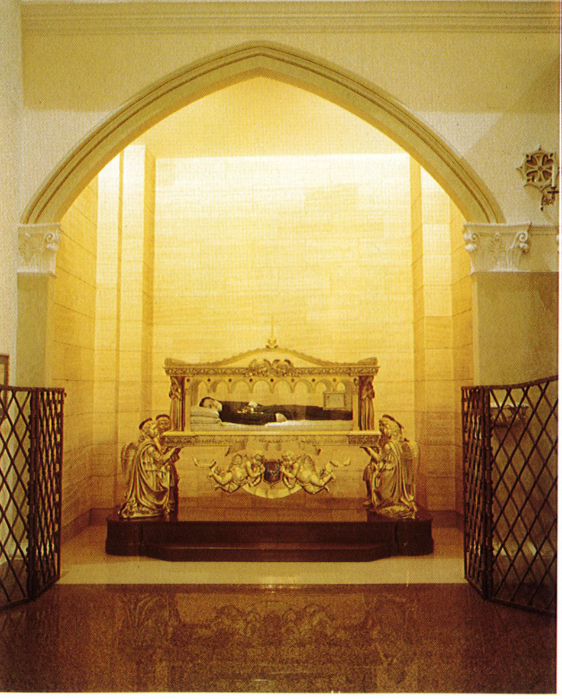
The head of our Holy Mother which, under the influence of the Spirit, ignited the spark that in that little woman gave impetus to the prodigious dynamism of the Cabrinian path to holiness, passed through the streets of Rome, from the Parioli to the Ludovisi quarters, in silence and anonymity. We were not able to accompany Mother along the streets, because the times did not so permit, but we joined her afterwards to express, with a solemn Liturgy, the joy of seeing the urn enclosing her precious relic placed in the church that Mother Cabrini herself had wanted and built, and in which her spirit was blessed in her encounter with God.
We move to the United States and our first stop is at the St. Frances Cabrini Shrine in New York, where Mother Cabrini’s body is kept. Here is how the history of the Saint and the New York Shrine became intertwined.
Shrine History – New York 1933: The Initial Examination
After Mother Cabrini’s death in 1917, she was buried in West Park, New York, overlooking the Hudson River. This was one of her favorite places and the site of the American novitiate and a large orphanage. The official process to determine whether she was a saint began in 1928, just over a decade after her death.
In 1933, her mortal remains were exhumed by the Roman Commission in the presence of the Apostolic Delegate. On that occasion, it was discovered that her body was subject to the normal process of decomposition.
Mother Cabrini’s remains were reburied and carefully transferred to the chapel of Mother Cabrini High School at 701 Fort Washington Avenue. They were placed in a sealed urn under the altar dedicated to the Blessed Virgin Mary.
As part of the beatification process, a panel of experts must examine the mortal remains to ensure that they truly belong to the right person. Thus, in 1938 Mother Cabrini’s body had to be exhumed and examined again.
Anatomical experts and the Postulators of the Cause arrived from Rome to follow the detailed process of creating a “certificate of recognition.” The examination took place over several days in silence in a secure room at Mother Cabrini High School.
History of 701 Fort Washington Avenue by Sr. Barbara Staley, MSC
Once the examination was completed and deemed in order, Mother Cabrini’s body was dressed in her religious habit and placed in a crystal coffin. A wax mask of her face and hands was placed over the relics to help pilgrims visualize her as she had been on earth.
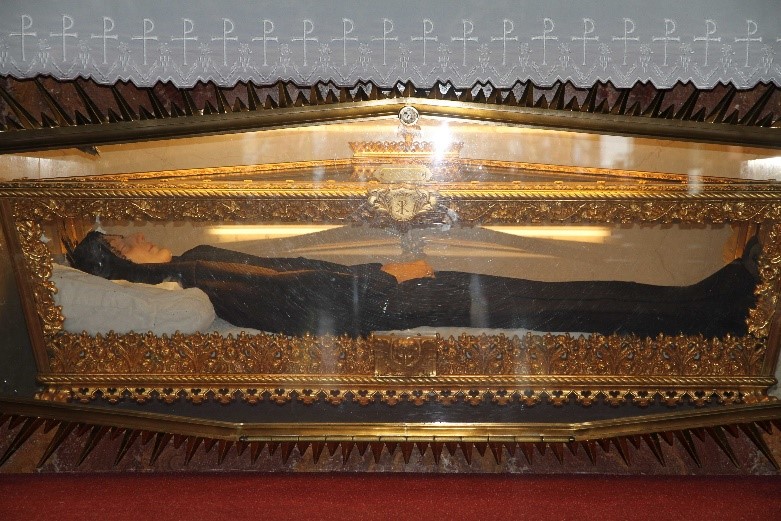
Before the coffin was closed and sealed, the Missionary Sisters of the Sacred Heart and Cabrini High School girls were allowed to walk past it. Those who had a rosary in their hands were able to place it in contact with Mother Cabrini’s feet.
“The formalities completed, the heavy gold and glass was moved into place on top of the coffin – so heavy that sixteen men were required to bring it into the school – and Monsignor Natucci personally sealed the coffin, which will never be opened again.” (New York Herald Tribune, September 14, 1938)
Frances Xavier Cabrini was proclaimed a saint at 9:05 a.m. July 7, 1946, by Pope Pius XII.
Cardinal Francis Spellman celebrated Mass in the chapel of Mother Cabrini High School in New York at the same time as the papal Mass in Rome.
According to the New York Times, more than 45,000 people passed through the Mother Cabrini High School chapel on July 7, 1946 to venerate the relics of the new saint.
The continuous flow of pilgrims to the chapel was welcome but made it difficult for the school to function normally. To accommodate the visitors, the Missionary Sisters decided to build a separate shrine to house Mother Cabrini’s remains. Construction began in 1957 and was completed in 1959.
Today, Mother Cabrini’s remains continue to rest under the Shrine’s main altar, welcoming people to learn from her example of a life of heroic virtue and to draw closer to God.
(https://cabrinishrinenyc.org/all-about-relics/)
A first-class relic of St. Cabrini enclosed in a bronze and crystal coffin is preserved at the National Shrine of St. Frances Xavier Cabrini in Chicago.
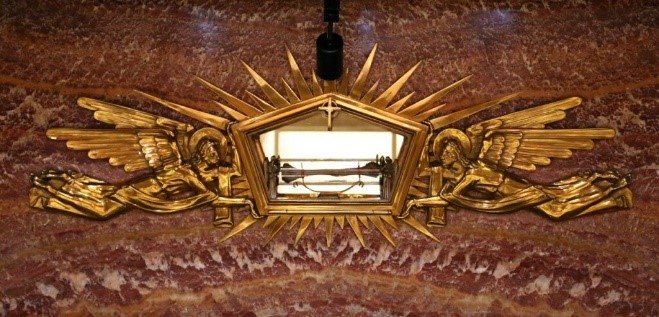
The shrine’s website states:
A shrine is a Catholic church or other sacred place that houses the remains or relics of a saint or other holy person, the object of religious veneration and pilgrimage. A National Shrine receives this higher distinction from the National Conference of Bishops in order to recognize its
special historical, cultural and religious significance. This is a National Shrine dedicated to St. Frances Xavier Cabrini, the first American citizen saint and patroness of immigrants. Pilgrims from all over the world come for the purpose of having a profound religious experience. The furniture in her room and other artifacts are preserved here. All are welcome in this sacred place.
The Shrine offers a remarkable opportunity for people of all faiths to renew themselves spiritually and deepen their relationship with God through prayer, Eucharistic celebration and adoration. It also offers a wonderful opportunity to learn about the fascinating life of Mother Cabrini.
(https://www.cabrininationalshrine.org/what-is-a-shrine–)
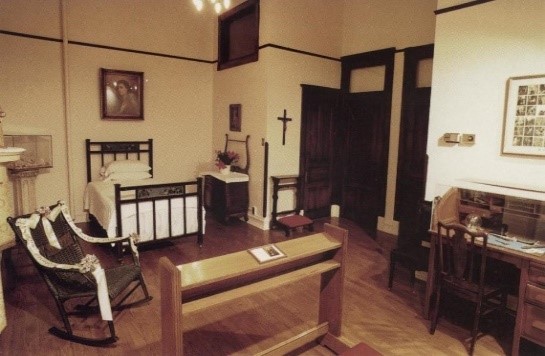
Several relics of a different nature are preserved in the Mother Cabrini Shrine in Colorado, where a part of her finger is kept, or also in the Chapel of the General Curia in Rome where an ex capillis relic (a lock of hair) is found. It is impossible to know how many more there are in the world whose traces have been lost. What is important, however, is to make Mother Cabrini known all over the world. As she herself said, “If I could spread my arms and embrace the world to give it to you, how happy I would be.“
Also in Sant’Angelo Lodigiano, kept in the Little Chapel of the Missionary Sisters of the Sacred Heart of Jesus, we find a small piece of Mother Cabrini’s heart.
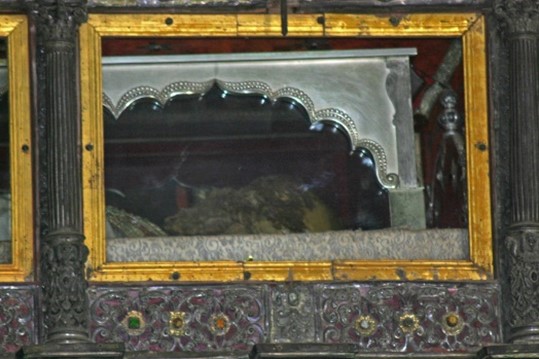
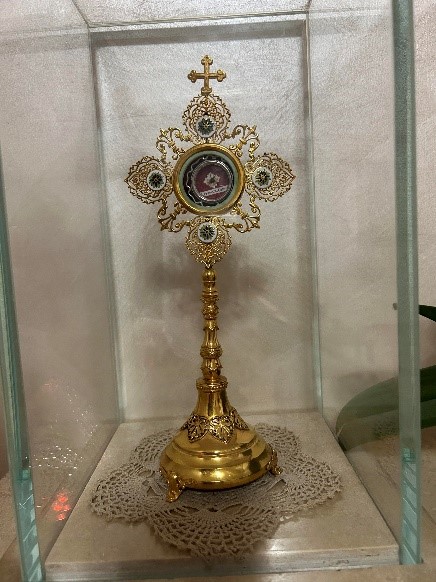

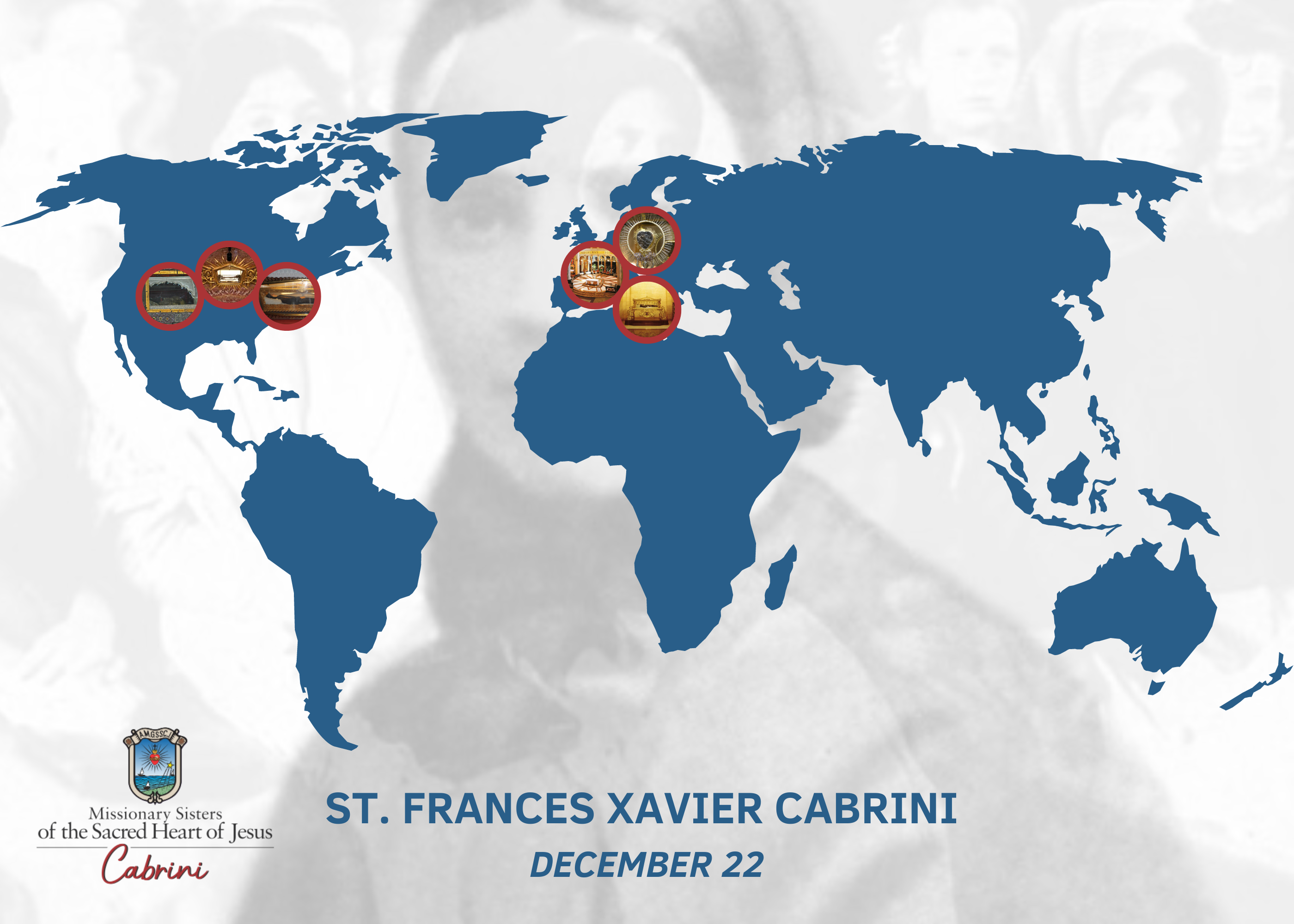
Dear Sisters, I am looking forward to viewing the move, “Cabrini” in the next few days. However, I came to know about Mother Cabrini through Sr.Emmanuel (Lucy) Falcone, who was a niece of my father. I’m wondering if any of your Sisters would remember her. God Bless you as you continue the wonderful work of Mother Cabrini. Sincerely, Anna Pinto
I have been to the shrine numerous times. My aunt Nancy Zito was dedicated to Mother Cabrini and introduced her to me. Upon going to the shrine in NYC I met Sr. Adelina Mare, who I became friendly with, letters, cards, visits. I also saw a miracle when my daughter could not get pregnant. Sr. Placed the relic with a piece of Mother Cabrini’s liver in it. Approximately 10 months later my twin grandchildren were born!
They became Knowles as the Cabrini twins.
Since then I have given pictures, bracelets etc of Mother Cabrini to those who need to be healed and helped. I have Mother Cabrini statues, pictures etc throughout my house. I am often asked to please pray to her upon request for health, needs and miracles. I thank Mother Cabrini everyday through prayer and meditation.
Pray to Mother Cabrini, she is so powerful!